Tulum, Mexico is a beach-bums paradise that is now one of the trendiest places to vacation in Mexico– and with good reason. This charming little slice of Mexican bohemia is mostly known as a chic oasis where people go to live slow and take a breather from faster-paced lives elsewhere.
In recent years, the word’s gotten out about what used to be Quintana Roo’s best-kept secret– but that hasn’t stopped the rejuvenating hippie culture of Tulum from maintaining its strong cultural foothold.
There is, moreover, nothing quite like it. Tulum is a magical, restorative place with lots of hidden gems worth exploring– especially when you know where to go.
For the quintessential experience, stay at a hotel on Carretera Tulum-Boca Paila, the welcoming “main drag” along the beach. Carretera Tulum-Boca is Tulum’s sleepy, beach-adjacent street where the area’s best restaurants, cafes, shopping, clubs, and curiosities like tattoo parlors and beachside swingsets are located.
It’s a fabulous place to wander, dine, ride bikes, and refresh yourself before, after, or during a visit to the area’s real star: Tulum Beach. (Known for its powder-fluffy sand, crystal clear blue waters, and mild surf.)
Otherwise, opt for a more secluded bungalow stay near the eco-reserve at the end of the hotel zone. (We make recommendations for both styles of hotel, below.)
-
Tulum Beach vs. Tulum Pueblo
It’s also worth noting that Tulum is broken down into two areas: Tulum Beach, and Tulum Pueblo.
Tulum Beach is likely the area you imagine when you envision a Tulum vacation. Tulum Pueblo– aka “town”– is known for its commerce and is, frankly, less popular with visitors. Staying in Tulum Pueblo, however, can allow for much cheaper accommodations. (Though these are about 1 mile away from the beach, on average.)
Either way, no matter where you stay, Tulum remains a very eco-friendly place that’s known for its breezy hippie vibe. As a result, electricity and internet connectivity at most residencias is minimal, even since the advent of smartphones. And that’s part of the charm!
Ultimately, Tulum is not a place where I recommend planning a full, jam-packed itinerary ahead of time. (Save for a visit to a local cenote or spa– but again, we get into that more below!) Really, the point of spending time here is just to rediscover the art of hanging out.
Tulum is the ultimate relaxing getaway for a reason. There’s so much lovely stuff to do here, from biking along beach road to barefoot dining, dancing under the moon, lounging in beachside hammocks, shopping locally, and enjoying cocktails, a smoothie, or ice cream right on the beach.
^ All that stuff is here, for sure, but if you can happen upon it organically, slowly, and casually, you’ll get even more out of your trip because you’ll truly embody what it means to live like a local. Time moves luxuriously slowly down here– and you’ll really only come to know that once you arrive. (Much like Fiji, Tulum is a place that runs on its own clock.)
Thus, it is with all these details in mind that we present the below Insider’s Guide to Tulum, Mexico– spotlighting several wonderful things to do, see, eat, explore, and discover in the area.
Like all of our Travel Well guides, it’s optimized for unique experiences that capture the singular essence of the place. Do anything on this list and you’re sure to have a great time– we promise.
Bookmark this list for easy reference later.
Enjoy your trip!
***
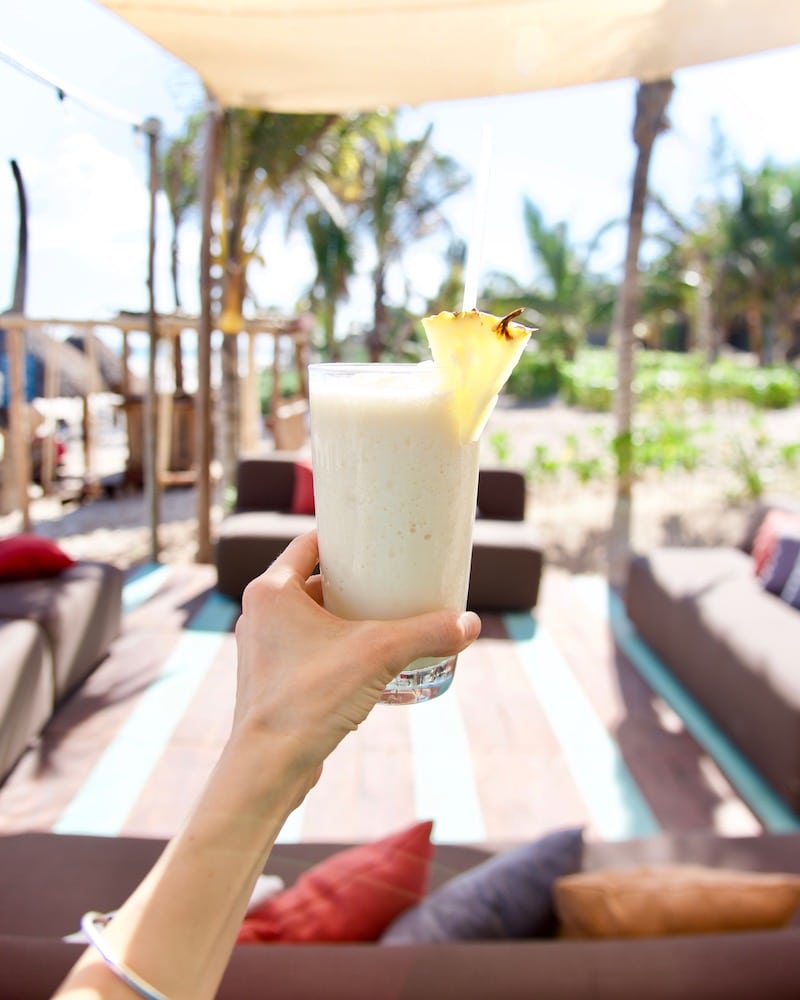
The Best Things to Do in Tulum, Mexico
What to do for the signature experience in Tulum– plus a few hidden gems.
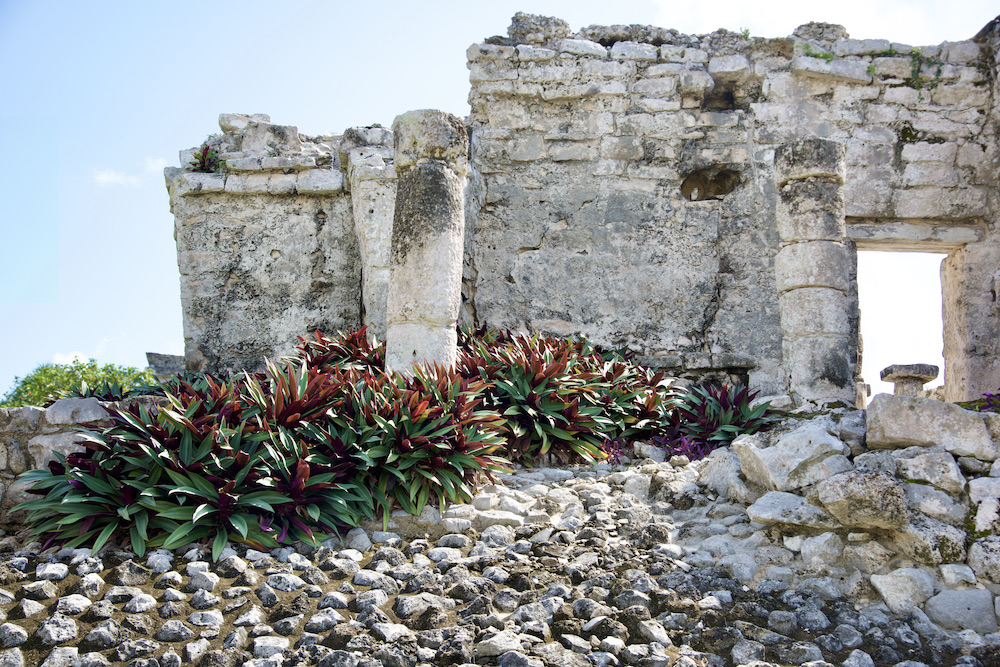
Visit The Mayan Ruins (La Zona Arqueológica de Tulum)
The Tulum Ruins– also known as “la Ruinas” at the Zona Arqueológica de Tulum— are Tulum’s main claim to fame. A vacation in Tulum, moreover, isn’t complete without a visit to The Mayan Archaeological Site at Tulum National Park.
The so-called Tulum Ruins are by now as synonymous with Tulum as the beach itself. The site was built in the 13th century on a 12-meter cliff overlooking the Caribbean Sea. Importantly, it was one of the last cities inhabited by the Mayan people.
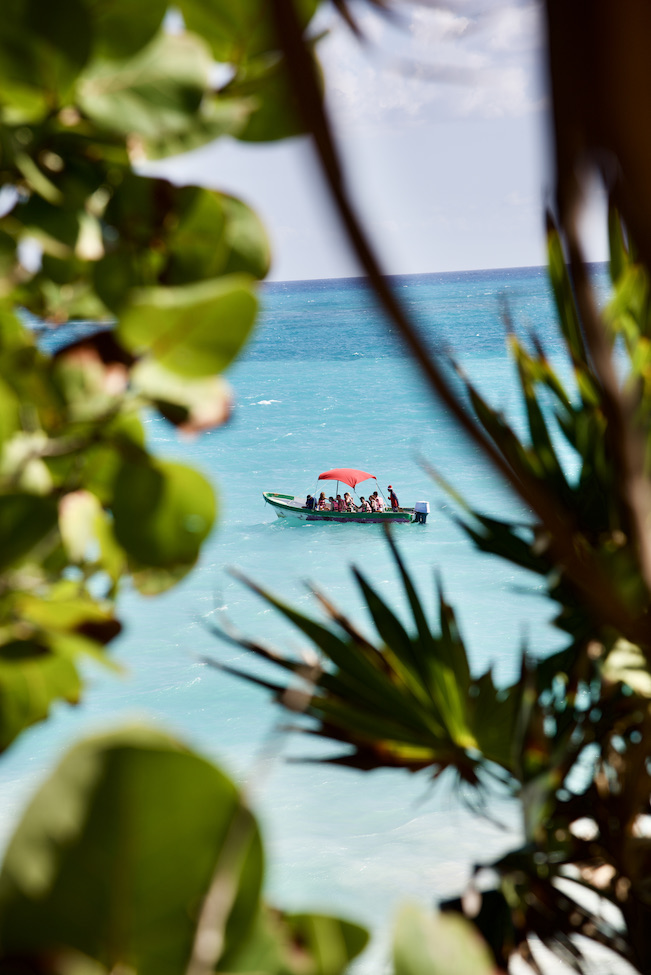
Soon, it became one of the most important ports in Mexico, overlooking a secluded grotto that travel critics have referred to as “the world’s most perfect beach”, all clear turquoise waters and white sand.
The beach is reachable only by a narrow wooden staircase that leads down from the ruins. (It’s drilled into the side of the cliff.)
Watch locals swimming in the warm topaz waters from the overlook, or hike down and have a dip yourself. It’s lovely even just dunking your feet on a hot day. (See below!)
Purchase entry tickets on-site or book them ahead of time. Booking ahead is ideal if you don’t have time to make a day of it, as crowds can swell during peak visiting hours, usually between 10 AM and 3 PM local time.

You can visit the Tulum Ruins with a guide or on your own, but I would recommend the latter as it allows you to linger where you like. This place can get very busy during peak hours, and the sun is very strong at high noon.
My recommendation is to go in the late afternoon when the tourists from European cruise ships have left and the light is soft and glowing. It will also be cooler and the beach below the overlook will be less crowded.
Be sure to look for iguanas and enjoy the palm trees, bougainvillea, and other ancient jungle foliage! The soundscape is immersive and feels vaguely mystical.
The most iconic relics here are El Castillo, which overlooks the ocean and is one of the most photographed backdrops in Tulum, as well as El Templo de La Pinturas (Temple of the Painters), which features partially-restored original red murals.
^ Seek these two out for the most iconic pictures!

Snorkel Through a Cenote at Parque Dos Ojos
Parque Dos Ojos— located on the Mayan Riviera between Tulum and Playa Del Carmen– is a gorgeous place to experience swimming in a cenote, aka an underwater karst cave. Swimming in a cenote is a quintessential experience for adventurers and water enthusiasts visiting Tulum, and this one, in particular, is quite beautiful.
Parque Dos Ojos, moreover, is a place that Los Ancianos referred to as a “portal to the underworld.” The cenote gets its name because the two largest pools in this karst cave system look like two eyes. The entry pool (above shown) connects to an underwater bat cave (literally!) which can be just as awesome as it is scary, depending on your level of comfort with claustrophobia. (This is Mexico, after all, the land of spirits. You don’t even have to sign a waiver before they send you into the darkness! Enter at your own risk.)
Cenotes form when limestone is shaped by the slow trickle of water into the bowels of the earth. As a result, there are thousands of stalactites and stalagmites here that are millions of years old, and the waters run perilously deep. (This is why your guide probably won’t even let you dive down to see the hole– because historically “many who do so do not return.” Yeah, it’s that kind of place.)
Ultimately, you have to be comfortable with some level of spooky mysticism for this to be worth your while. But for geology buffs, it’s absolutely magnificent.
The Mayan people thought that these cathedral-like caves were portals to the underworld: because one of the cenote’s most striking rooms can only be accessed by swimming through a room whose ceiling is so low that you have to go underwater to get to it.
This atrium is filled with hundreds of incredible stalactites hanging 30 feet from the ceiling, like a bushel of ginormous rock icicles as old and magnificent as Time itself. Here, thousands of winged bats sleep aloft. You will hear them before you see them.
(Passing through this tight space is not for the faint of heart, which is why I only recommend this experience for good swimmers and those who are not claustrophobic. Again, all who enter here do so at their own risk. If you don’t feel comfortable doing a guided tour of the cenote, just stay and swim in the open pool area. It’s still lovely!)

Spend Time on Tulum Beach (Walking, Swinging, Working Out, and/or Cocktail Drinking)
Sitting under a cabana or swing on Tulum Beach is a representative experience of the place.
Many area hotels offer private yoga classes or workout sessions with a private trainer on the beach, but ultimately it’s just the perfect place to get out for a walk by the ocean, or to take in the sunrise.
Sun worshippers love the turquoise blue waters and powdery white sand that is so strongly associated with the Carribean. City visitors, meanwhile, love the serene quiet and peaceful lap of waves.
Alma Tulum Hotel (detailed below in our hotel section) has beautiful, rustic wooden swings on the beach next to their shaded cabanas. It’s an ideal place to sip a fresh piña colada (virgin or regular!) made with locally sourced pineapple!
Or, visit any of the beachfront cocktail bars or restaurants and order another tropical cocktail of choice– made with local fruit, sugar cane, and other local delights.
If possible, try to stay at a hotel located directly on Tulum Beach– we list some recommendations, below. If you’re lucky enough to be there, you’ll be able to hear the crash of waves from your bedroom. (It’s the best, most relaxing lullaby ever!)
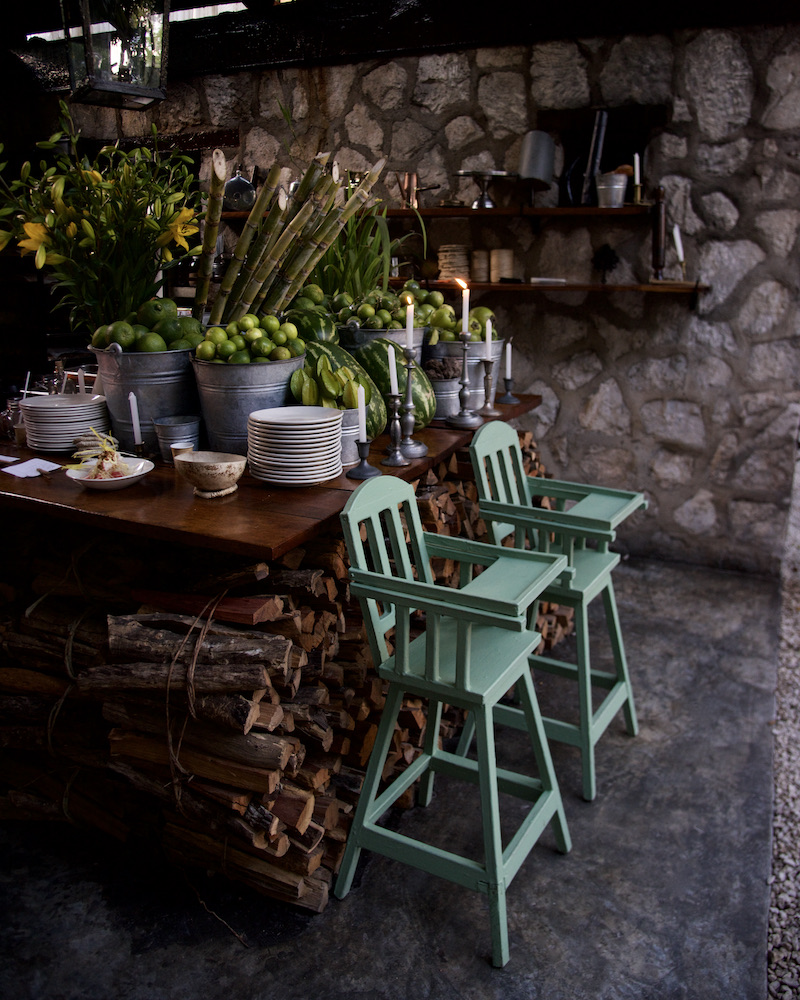
Have Dinner at Hartwood (& Be Sure to Reserve in Advance!)
Hartwood is one of the best restaurants in the world– literally. And it’s also the most rugged– they don’t even have electricity! The food at this famously “off grid” restaurant is cooked over an open flame, and ice is delivered 3 times a day for refrigeration. The dining room is even tucked inside a sand pit in the jungle, on the side of Carretera Tulum-Boca.
Eric Werner and Mya Henry launched the restaurant in 2011. Since then, it’s become a mythic and often whispered-about foodie destination whose reputation precedes it.
People used to make reservations months and even years in advance, but it’s still sometimes possible to walk up if you don’t mind eating at the bar or super early (like a 5 PM dinner).
The restaurant is famous for its jungle-foraged produce and freshly-caught seafood. (They pull the fish off the boat just hours before they serve it. And it’s sometimes not even that long!)
Here, tropical fruit sits in gorgeous, Eden-like mounds on the chef’s open wood-fired kitchen and prep area at the back of the restaurant. Pineapples are strung like Christmas lights above heaps of watermelons, lime, jicama, and sugar cane (which they use liberally at the bar).
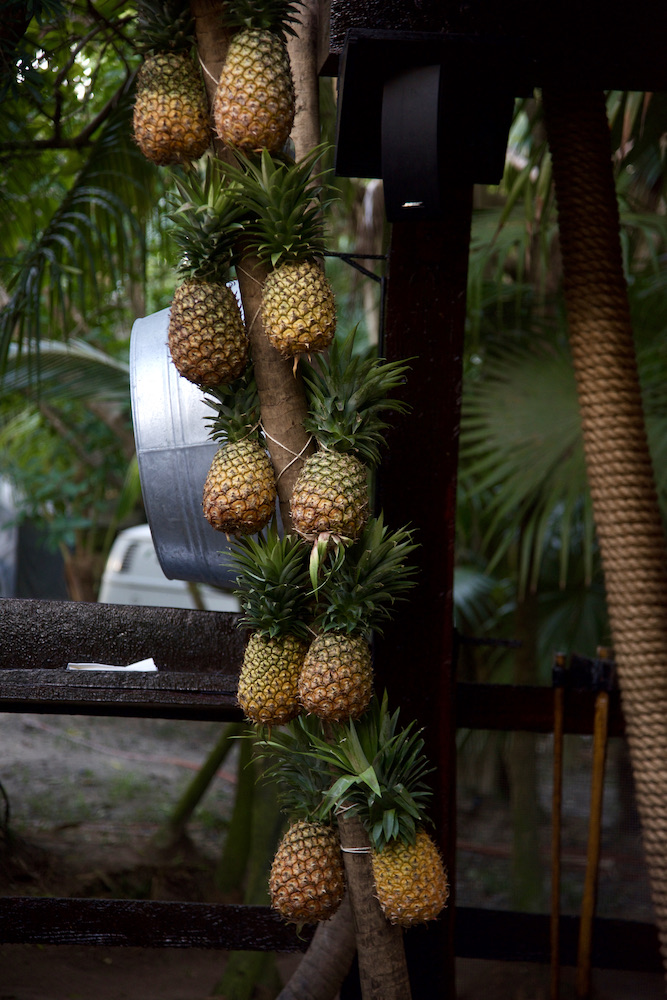
Try Hartwood’s Signature Habanero Cocktail for the quintessential Tulum mixology experience, and order the Catch of the Day for dinner.
Past appetizer treats include adventurous twists on staple produce-forward dishes like wood-fired wild chamomile beets and Yucatán Ceviche with fresh ginger and mezcal. Or, try the local Punta Allen octopus (a local delicacy that tastes like a cross between duck and lobster!).
It’s all delicious, and always worth the hype for the experience alone. This is definitely a Bucket List destination for foodies, but at the very least, it’s one of the few places in the world where one can comfortably have dinner at a fine dining restaurant while simultaneously dipping their toes in the sand. 🙂
Foodies: you will absolutely need to make a reservation in advance. Don’t miss out!
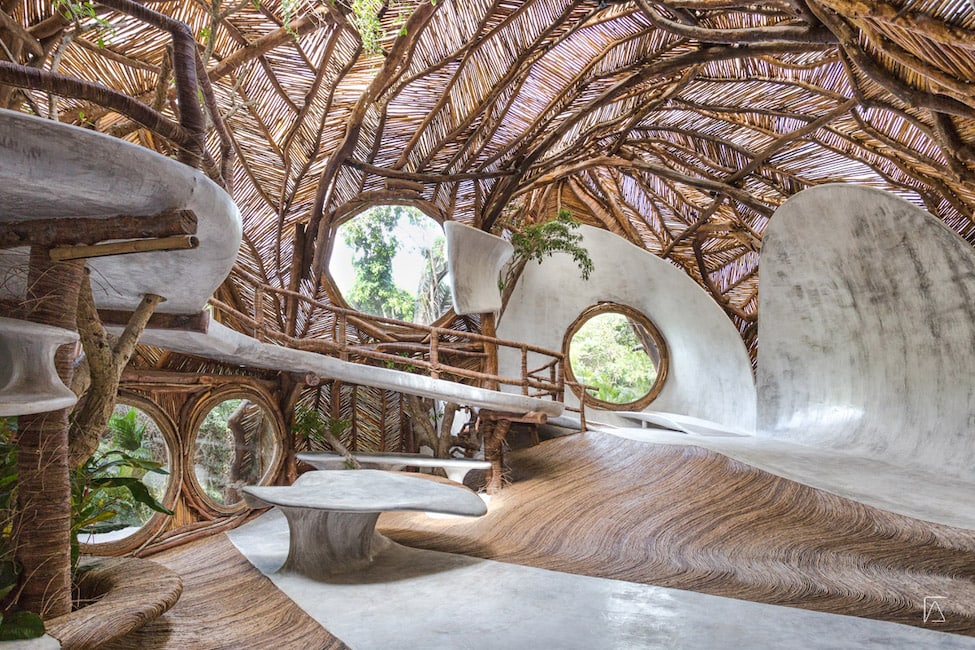
Explore SFER IK Art Museum
Welcome to the jungle, indeed. The SFER IK Art Museum is a real hidden gem in Tulum. Beginning with the transfixing foyer (above), Tulum’s SFER IK gallery explores the alluring “vitality of the jungle” and “the connection between the arts and nature in an awe-inspiring architectural landscape that will captivate your mind, body, and spirit.”
The museum also encourages sustainability through meaningful tourism (hey, us too!) by focusing on art and other cultural engagement in the context of the natural world.
As a travel concept, it’s emblematic of how to between integrate thoughtful environmental tourism into destinations near the world’s most vulnerable ecosystems (like the Sian Ka’an Biosphere Reserve in Quintana Roo, detailed below).
That, and just look at these sight lines! The space is totally gorgeous and even better in person. Art lovers, do not miss this!
As of this writing, this “museion” is open from 10 AM to 10 PM daily. Tickets are $10. Get more information here.
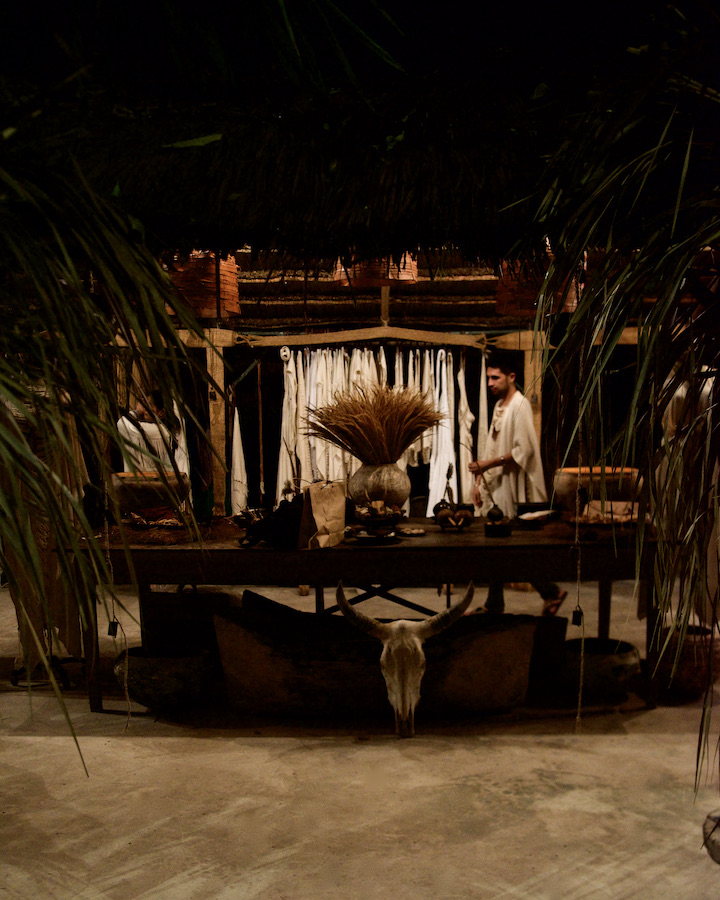
Shop One-of-a-Kind Yucatan Products at Caravana
Shopping on Carretera Boca Tulum is a unique if somewhat touristy experience– but there’s a lot of great and singularly creative stuff to be found here.
Head to Caravana Tulum to shop for interesting leather goods and other lovely curiosities that capture the aspirational style of this at-times bougie beach town. Caravana’s flagship tent– yes, tent— embraces “the magic of Tulum’s spectacular coastline” with its airy interior and ambient jungle sounds.
This shop is esoteric in concept, but clear in vision. They have really great handcrafted accessories and apparel, from dresses, skirts, pareos, jumpsuits, and kaftans to shirts, pants, capes, and vests.
It’s all beautifully made, and a little esoteric. Every collection draws inspiration from the healing arts and spiritual traditions of the Yucatan Peninsula.
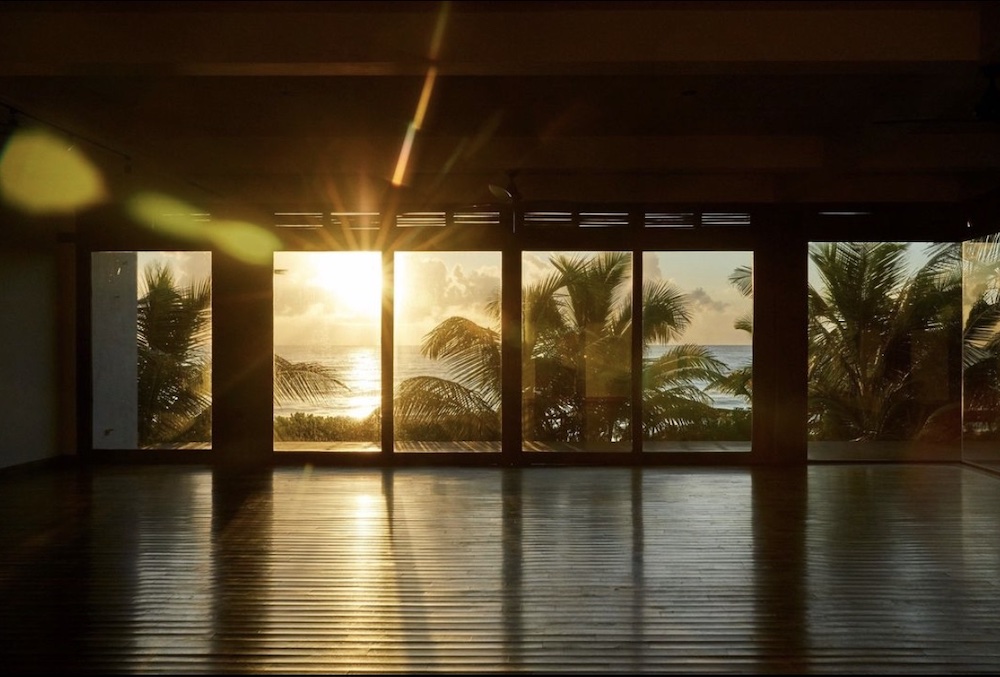
Do Beachfront Yoga at SANARÁ
Hotel Sanara Tulum offers gorgeous beachfront yoga classes with serene views of the ocean and surrounding jungle. If you’re looking for a lovely place to do yoga in Tulum, this is one of your best bets!
Here, instructors from all over the world teach all-level yoga classes in a range of styles, from Aligned Yoga and Power Flow to Vinyasa, Hatha, Kundalini, and Yin Yoga. Ultimately, it’s a real yogi’s yoga studio (they even have singing bowls and sound gongs!) that channels the uplifting energy and calming vibrational spirit of this special region of the Mayan Riviera.
The beachfront yoga shala sits 4 feet above the sand, which allows natural beach movement to occur. (All coasts migrate over time, so this is a nice sustainability feature that helps future-proof the space.) Plus, the yoga room itself is enclosed, so you can stay cool while you practice. The best of both worlds!
The hotel offers a weekly program of yoga and meditation events, as well as occasional day retreats, private sessions, and classes that are open to the public. (Even those not staying at the hotel.)
The hotel’s name, Sanara, means “you will heal”– that pretty much says it all.
To view the schedule and book a class, go here.
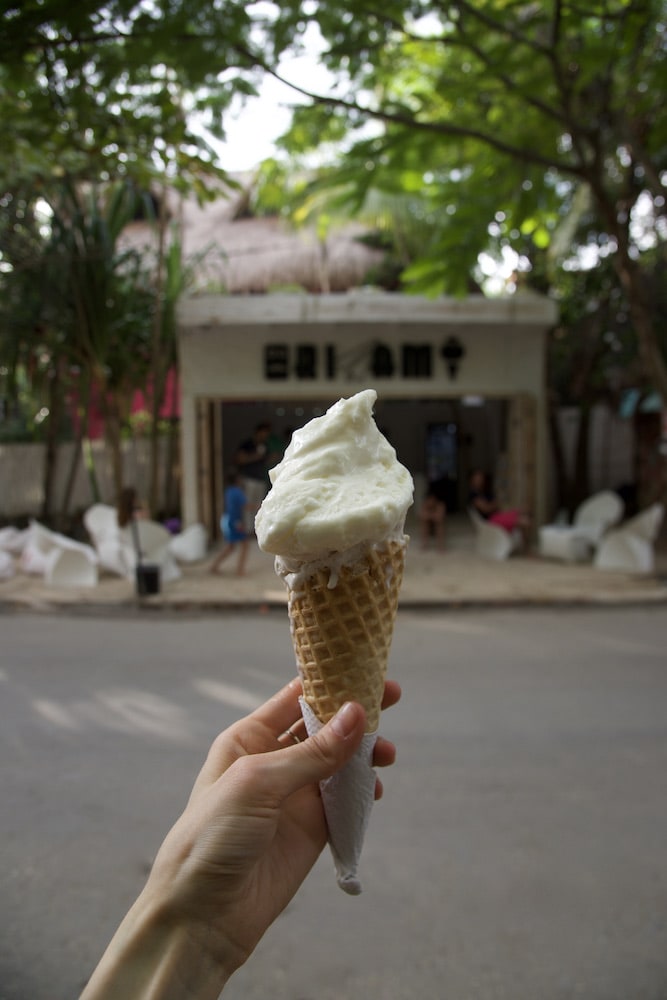
Get Local Ice Cream at Origami Gelato
Tulum’s best ice cream is actually gelato: Origami Gelato sells locally-sourced, regionally-inspired Mexican-style gelato that is, in my opinion, the best in all of Quintana Roo.
Expect intriguing, decidedly local flavors like Jungle Banana, Tulum Coconut, Mexican Vanilla, and Cinnamon. (<— A classic Mexican flavor when it comes to good ice cream!)
Here, they shellac decadent gobs of Tulum Coconut and Mexican Vanilla ice cream onto their cones with the kind of no-frills utilitarianism you usually only see in Italy. As a result, each cone looks like a sort of nouvelle objet d’arte. (See image, above.)
Enjoy your cone or cup from the comfort of their on-site beanbag chairs– yes, it’s kind of a dive, but it’s charming for that reason. Or, hop on their free WiFi if you want a reminder that the outside world still exists.

Explore The Biosphere Reserve of Sian Ka’an
A hike through the Biosphere Reserve of Sian Ka’an— with its lush, creeping vines and gorgeous unspoiled flora and fauna– feels like a scene from Indiana Jones.
This famous, protected wilderness at the end of the hotel zone in Tulum is fun to explore on foot or by boat. (You can also hire a boat and swim with dolphins!)
Ultimately, this is a great place for nature buffs and plant lovers to explore the unique landscape and botany of the Mayan Riviera. It’s much more rugged and unkempt than most designated parks in North America, so it feels in many parts like you are exploring a truly private world.
For the environmentally-conscious traveler, is a gorgeous place to book a personalized tour or excursion. It’s ideal for families or groups who want to avoid the mass tourism feel of large groups, as well. (They limit capacity to 6 people per tour in order to maintain the most intimate experience.)
Explore coast wetlands and shimmering lagoons, or book a reef snorkel in the Mayan Canal. For more information on the various tour offerings, go here.
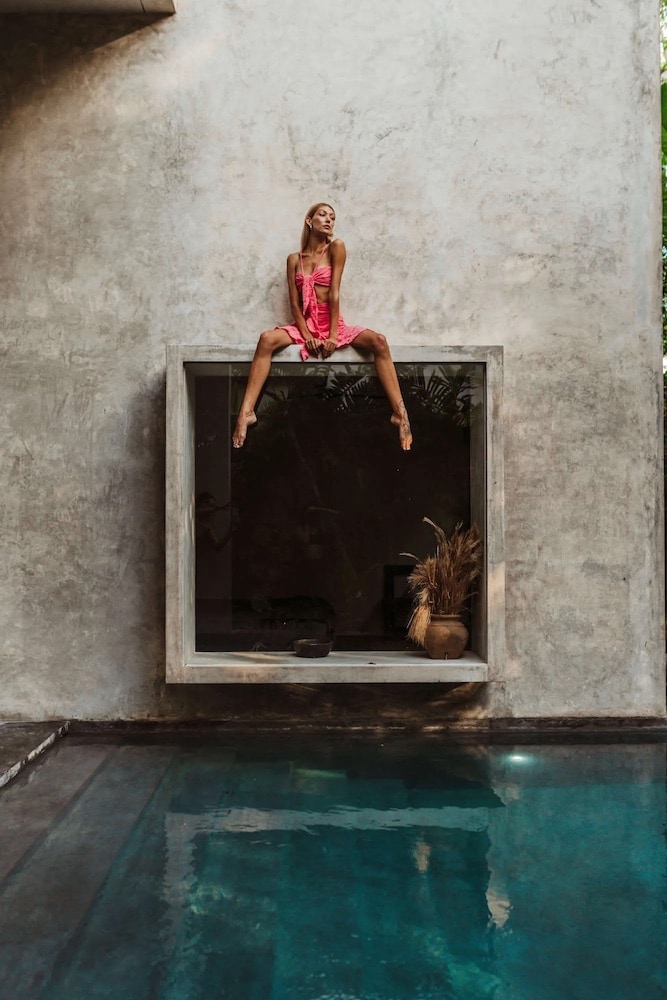
Shop Amazing Dresses & Rompers at Josa Tulum
Another fantastic place to shop for [women’s] apparel is Josa Tulum, which in part reflects a more global sensibility because it’s owned by a New York expat. (But don’t worry: all Josa Tulum products are designed in Tulum and made by local women in Playa del Carmen.)
Shop here for amazing dresses and rompers that you can wear on your trip or bring home as a souvenir whose style reflects the place of origin. Think: flowy floral kaftans, tidy botanical-inspired jumpers, and lots of sheer peek-a-boo fabric.
They are not afraid of prints or mixing textures, and each piece is designed to flow seamlessly from breezy days on the beach to fancy dinners at night. If ever there was an aspirational Tulum uniform, these pieces would be it.
We love their rustic and chic kimono-style maxis, and the fact that they last forever. (I purchased a jumper years ago that is still going strong, even after babies and thousands of airline miles.)
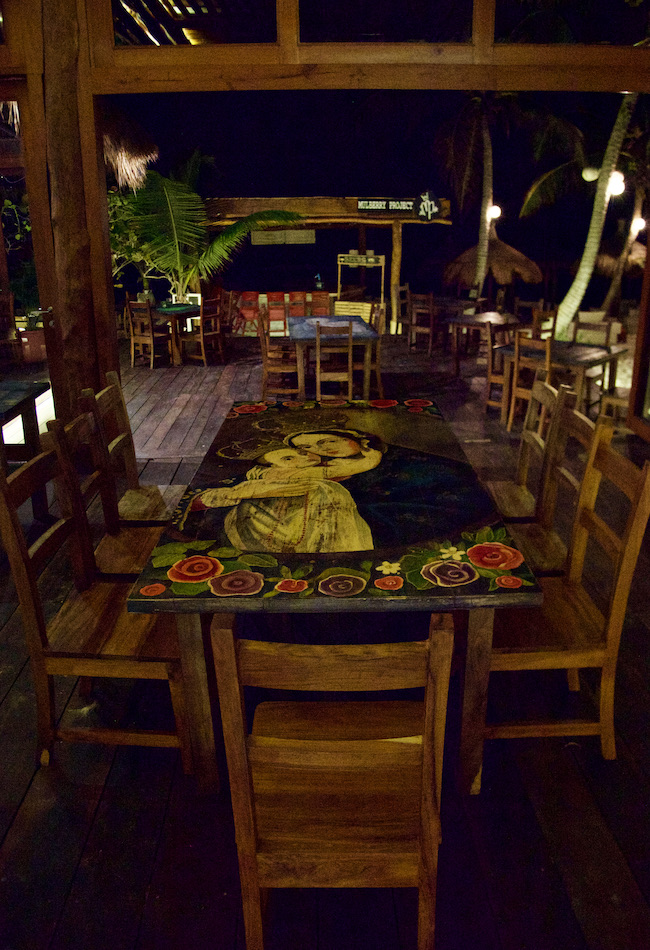
Eat The Best Tamales EVER at La Zebra
One of Tulum’s many fun-loving restaurants, La Zebra, has some of the best tamales on the Yucatan Peninsula. Go here and order them, specifically.
Otherwise, this beachside restaurant and bar serves authentic Mexican cuisine, and it’s great for walkups. (Like if you just landed at the airport and need to grab a quick but relaxing meal before bed.)
Locals frequently dine here, as do couples and families. The prices, moreover, are pretty fair for Tulum. To make it a more upscale experience, book a seat at the Chef’s Table for a guided tasting menu that reflects the bounty of the surrounding ecosystem and culture. It’s unpretentious and lovely.
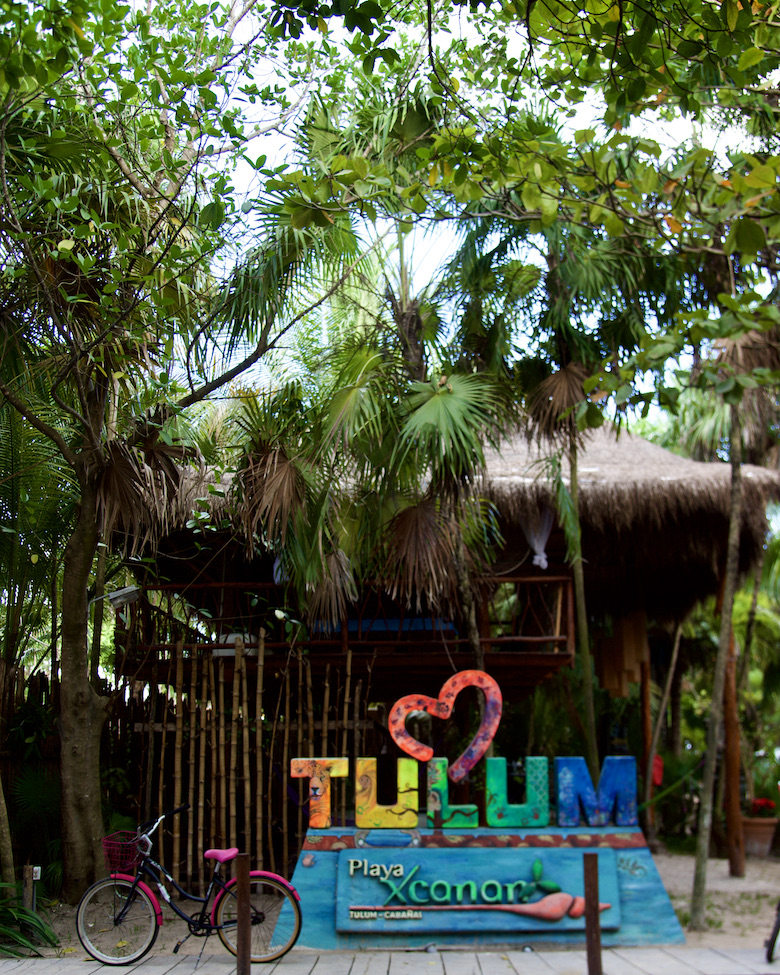
Bike Along Tulum Beach Road (A Great Place to Shop + Wander)
While it’s mostly known for the solitude and peaceful serenity of the beach, Tulum is also a decidedly lovely place to wander and shop.
Here, you can buy everything from bohemian clothing to dreamcatchers, organic body products, sarongs, vintage-inspired jewelry, jumpsuits, leather bags, knitted clothing, organic textiles, and various local artisan home goods like totes, candles, and baskets. The shops are typically lit up with twinkle lights at night, and there are lots of fun, colorful murals.
We’ve already mentioned a few local establishments by name, but it’s worth repeating that you should designate some time just to wander and explore. You’re bound to find something cool if you just follow your own curiosity.
For what it’s worth, Tulum is also a great place to get hipster tattoos, spa treatments, and bike rentals to make exploring easier. Ask your hotel about renting a bike (most have their own, and if not, they can refer you) and cruise down the main strip in style.
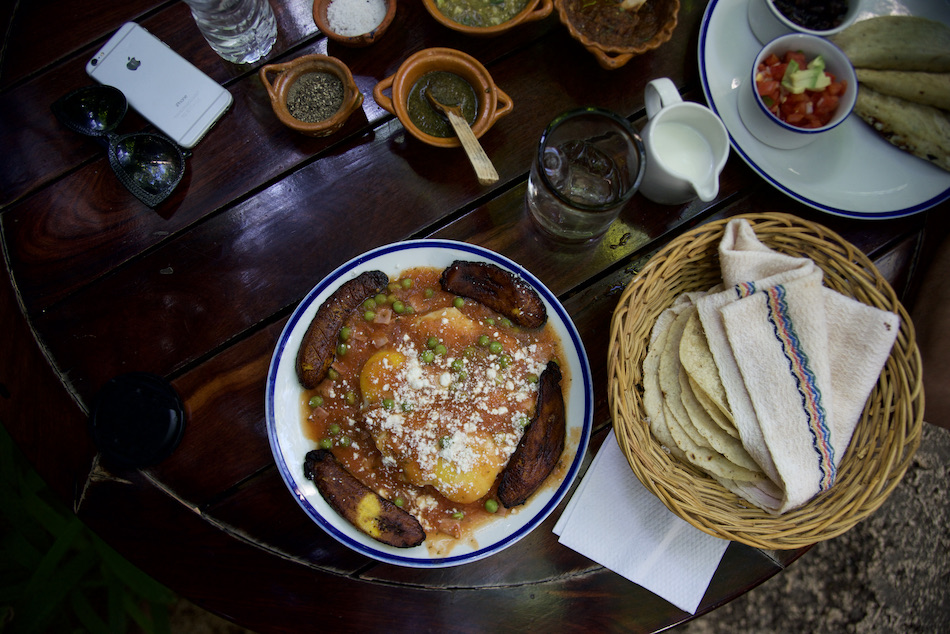
Go into “El Pueblo” to Enjoy a Traditional Mutalenos Breakfast (+ Shop for Iconic Double-Tread Hammocks)
As mentioned above, there are actually two sides of Tulum: Tulum Beach and Tulum Pueblo.
El Pueblo is the more urban part of town that’s separated from the beach by a long stretch of jungle.
For a decidedly different shopping experience, head into El Pueblo to enjoy a traditional mutalenos breakfast. These Yucatan-style eggs typically consist of fried tortilla topped with black beans, sunny-side-up eggs, fried plantains, avocado, salsa, cilantro and all the fixins’ (cilantro and jalapenos optional 😉 ).
Trying this hearty breakfast dish is a quintessential experience in this unique part of Quintana Roo. Many local restaurants do their own spin on this classic dish so you can’t really go wrong anywhere, but I like the gorgeous food at Del Cielo.
Then, for a more cliche (read: touristy but fun!) shopping experience, visit the central strip of local craft stores. Here, you can shop for Mexican Calaveras, keychains, Dia de los Muertos flags, prayer candles, copal incense, and the like.
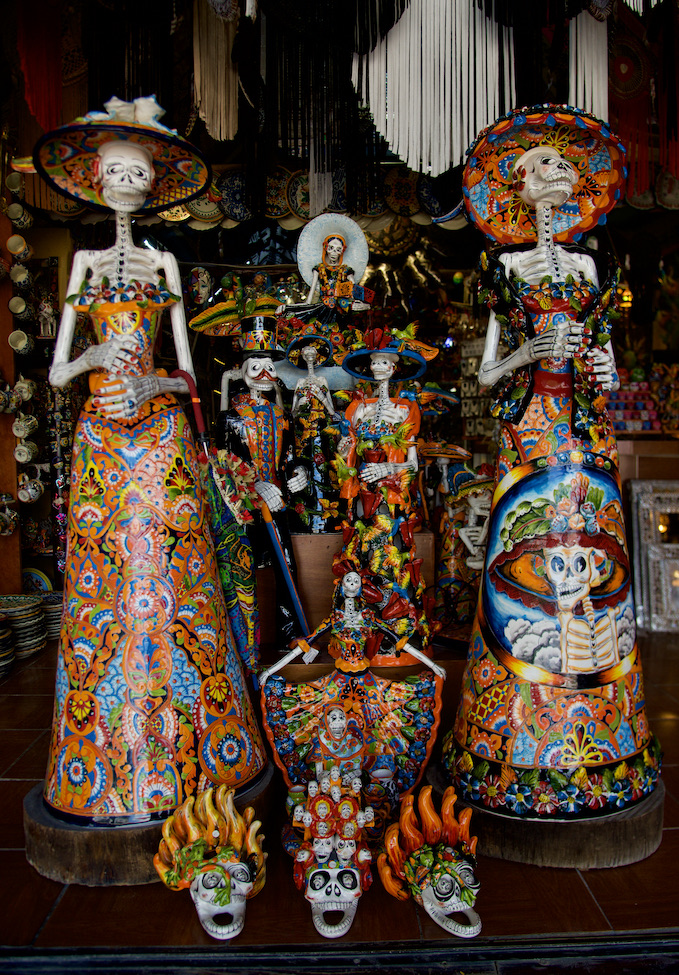
El Pueblo is also a great place to buy a traditional double-thread hammock, which is the artisan product that Tulum is best known for. (They function beautifully in any indoor or outdoor space, and make a great souvenir.)
Yucatan artisans famously make the best hammocks in the world, so this is more than an idle suggestion– especially if you are invested in the art of resting!
The shops here are busting with products that often spill over into the sidewalk. It’s a fun, tchotchke-filled atmosphere that is decidedly less upscale than Tulum’s beach road. But it’s ideal if you’re looking for quintessential Mexican souvenirs, or something a little more family and budget-friendly. (Just don’t be afraid to haggle over prices! Many vendors here will try to upsell you.)
The Pueblo is about a 10-minute drive from the beach. Most people bike or take a taxi, but the route along Av. Kukulkan is technically walkable and would take probably ~40 minutes or so.

Seriously: Relax in a Hammock
One of the best Tulum experiences is, quite simply, lounging in a hammock. It’s a classic experience of the place and an ideal way to “do Tulum right”. If you don’t end up buying a hammock, you can at least sit in one.
When you’re not walking on the beach or sipping a drink, consider setting aside some time for journaling, meditation, or daydreaming in a hammock. Most hotels have them– again, this is part of the rejuvenating hippie culture of Tulum.
Seek out una hamaca on Tulum Beach and be sure to dedicate some time for lounging to make sure it happens. (It’s easy to get caught up in wanting to plan lots of activities like snorkeling, dining, and visiting las ruinas. But, Tulum wouldn’t be Tulum if you didn’t spend some time just laying around at sunset. Trust me; your adrenals will thank you!)
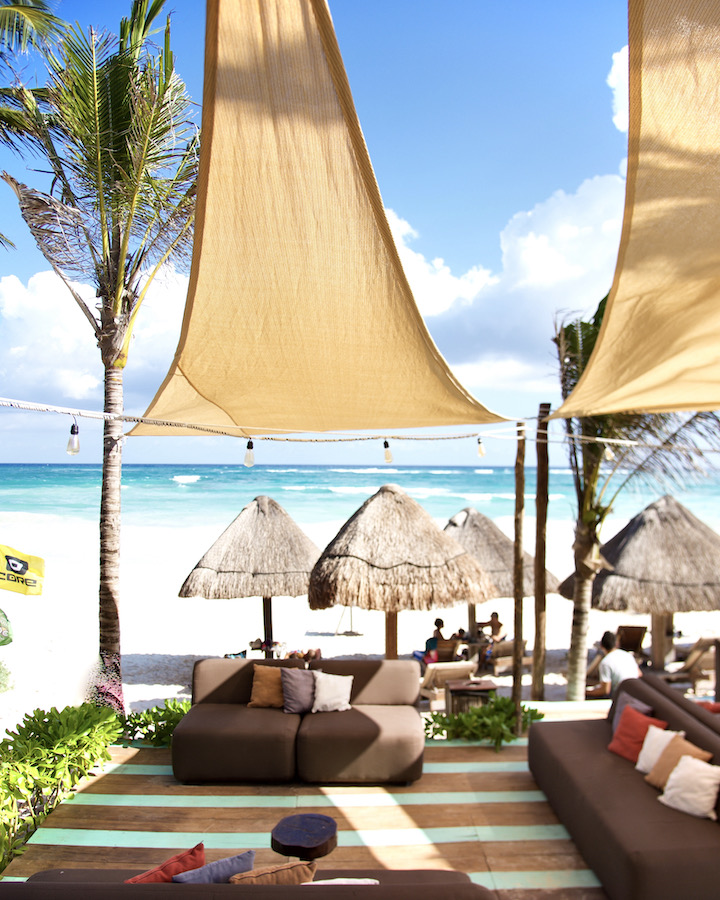
Meanwhile, Here Are Some of Tulum’s Most Charming Hotels
Cool places to make home base during your stay.
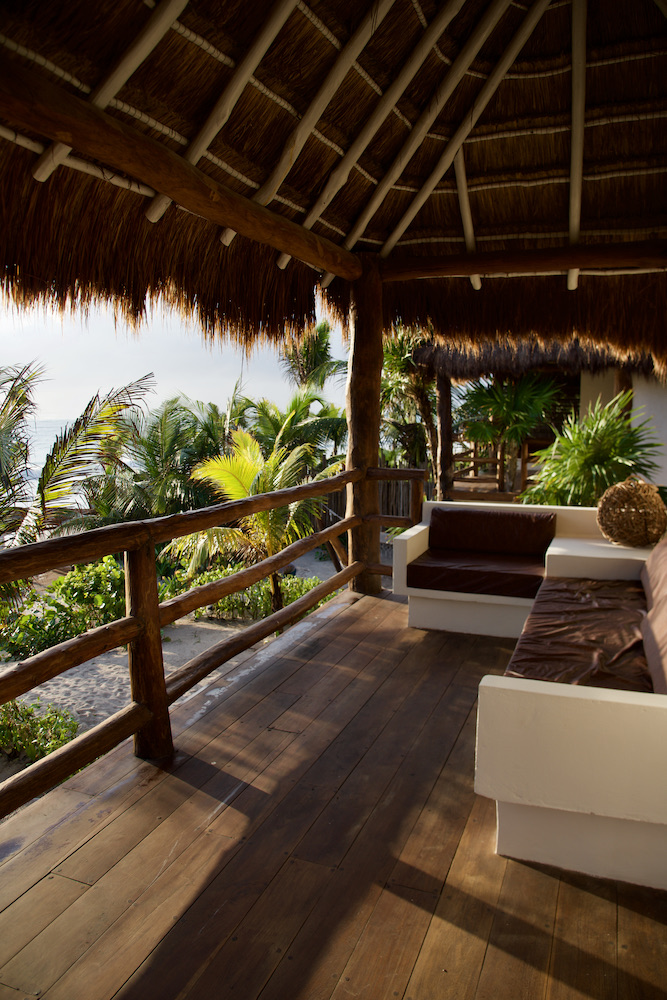
-
Alma Tulum Hotel & Restaurant ($$)
We love the breakfast, the view, the chill location, and the bungalow-style decor at Alma Tulum, a delightful, centrally-located Tulum hotel that’s ideal for first-time visitors.
With its central location on Tulum’s main drag, it’s an ideal place from which to explore this charming beach town.
Bike rentals are available at the check-in desk, and beachside hammock lounging is not only available but strongly encouraged.
The swings outside the hotel bar are ideal for sipping piña coladas or rocking gently under the stars. Or, simply sway to the sound of lapping waves. It’s lovely.
We also love the fact that you can hear the waves lap on shore from your bed. Most rooms have cute balconies overlooking Tulum Beach, which is just heavenly.
Rest in your personal hammock under the shade of a banana leaf, or enjoy a cocktail on a rustic, charming beachfront swing. (<—- This is a great golden hour spot for couples!)
The on-site hotel restaurant is also lovely, with generous breakfast service and a cocktail bar right on the beach. (And like all Tulum beach bars, they make great mocktails, too.)
Because it’s also relatively affordable compared to other Tulum hotels, Alma Tulum tends to attract young adults. (Rather than, say, families or rowdy college kids.) Stay here if you want the quintessential Tulum experience without breaking the bank!

-
Hotel Esencia ($$$)
Much more secluded is Hotel Esencia, a luxury hotel located on a beautiful, more private stretch of white sand beach in Tulum. The property is the former estate of a wealthy Italian heiress, and it shows.
Today, the huge rooms feature generous terraces and discreet service, meanwhile, the signature on-site restaurant, Mistura, is great. (There are a number of gorgeous restaurants on-site, but this one is my favorite and ideal for the quintessential experience of Tulum’s authentic gastronomic experience in a refined setting.)
Their gorgeous spa and health club, meanwhile, overlooks the site’s own private cenote. Book here in advance to receive truly awesome self-care treatments like massage, facials, baths, and bodywork that incorporates local botanical ingredients.
Hammocks and beach bar are luxe, with great margaritas– and the barrier reef is just 5 minutes away by boat, which the hotel can hook you up with. (It’s that kind of place.)
If privacy and/or luxury are your main preoccupations, stay here. (It’s great for honeymooners!)

-
Papaya Playa Project ($)
A paradise for sustainability-minded travelers, the Papaya Playa Project has eco-chic cottages that are basic but lively, with a beachfront pool and spa. It’s fun to go here for dinner at the on-site Roca Restaurant, as well, even if you’re not staying in-house.
Ultimately, the spaces here are minimal and wild– very indoor-outdoor, which is lovely as long as the weather permits (which it basically always does).
However, those who seek more creature comforts by way of linen service and luxury spa treatments, for example, would have to go elsewhere. (That’s a Hotel Esencia thing.)
Papaya Playa Project is also super affordable, so it tends to attract solo travelers and a slightly younger crowd. (Think college-adjacent folks, backpackers, and those comfortable with fewer frills.)
They also frequently have live music and immersive artistic events; this rounds out what the hotel refers to as their “barefoot luxury” aesthetic. Their casitas incorporate local materials and construction techniques, as well, which is why I recommend booking them when available. The villas, meanwhile, are a bit larger, ideal for couples and groups.
~ Honorable Mention ~
Tulum is a quaint, tight-knit community– and it’s only about 6 miles long. Most people only need a few days to explore it all. So, here are a few more fun suggestions for those who want to wander further afield.
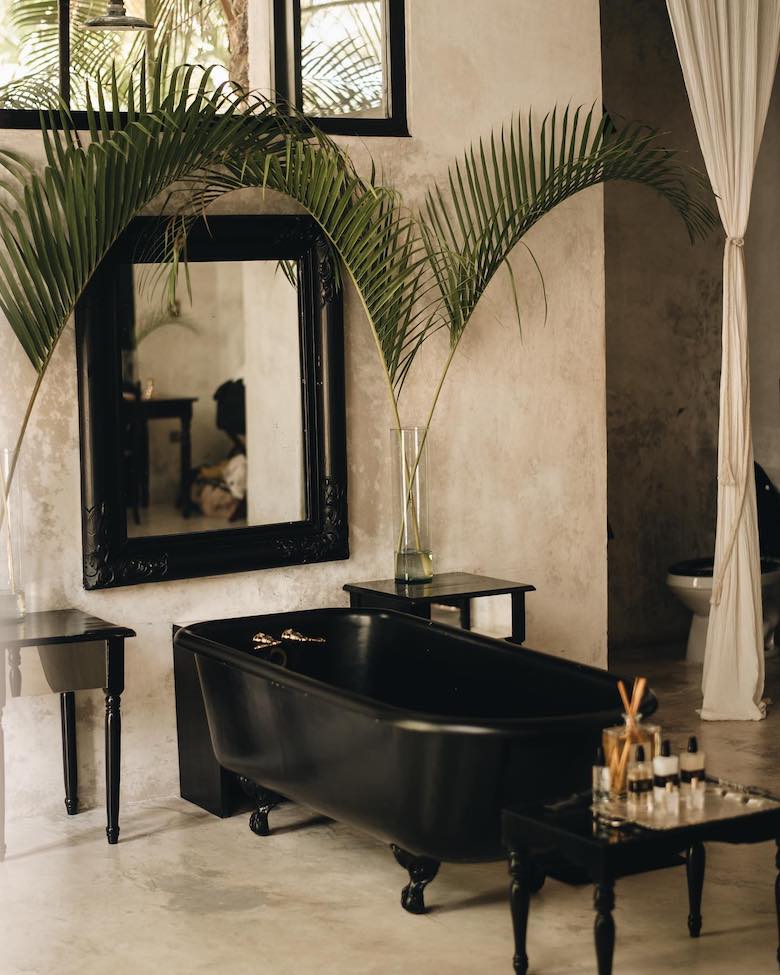
Day Trip to Coqui Coqui (in Coba or Valladolid)
Fragrance and spa lovers should consider taking a day trip to Coqui Coqui‘s Residence + Spas in Coba or Valladolid. Their bespoke perfumes have a reputation that proceeds them, the on-site spas are astoundingly gorgeous, and they sell lovely local artisan goods like banana leaf hammocks and handmade plant-dyed dresses.
The aesthetics here, moreover, are on point. Stay at the Coba residence for a chic overnight, or make a day trip to enjoy the spa and Coba’s lush gardens. The Coba location focuses on ancient and traditional healing treatments native to the Yucatan, and truly, the vibes are spectacular.
Spa treatments here combine the healer’s intuition, mind-body practices, and aromatherapy to bespoke experiences that are as magical as they are transporting.
The treatments themselves have gorgeous names, like “The Back is the Strength of a Human Being”, a relaxation massage for people with chronic back, neck, and shoulder tension; and “Relax The Circumference of Your Being”, a relaxing aromatherapy massage that encourages one to consider that when it comes to stress-relief, “we can only start from where we are”.
Coba is about a 45-minute drive from Tulum.
Coqui Coque also has a Perfumeria in Valladolid, which is part of their Only One Suite Collection. The spa here is a bit more traditional and sophisticated, which reflects the tranquil charm and strong cultural identity of the town. (Valladolid is famous for its folk art, baroque colonial buildings, and religious festival celebrating Madonna de Candelaria.)
Valladolid is about a 1.5 hours drive from Tulum.
All treatments incorporate the brand’s own signature scents, which are inspired by the region. (Think: lime & mint aromatics representing Coba’s lush gardens; Rosas Secas to encapsulate the tradition and charm of Valladolid.) It’s all lovely and totally gorgeous.
To book a spa treatment at either location, go here.
To book a stay in Coba, go here.
To book a stay at the Perfumeria in Valladolid, go here.
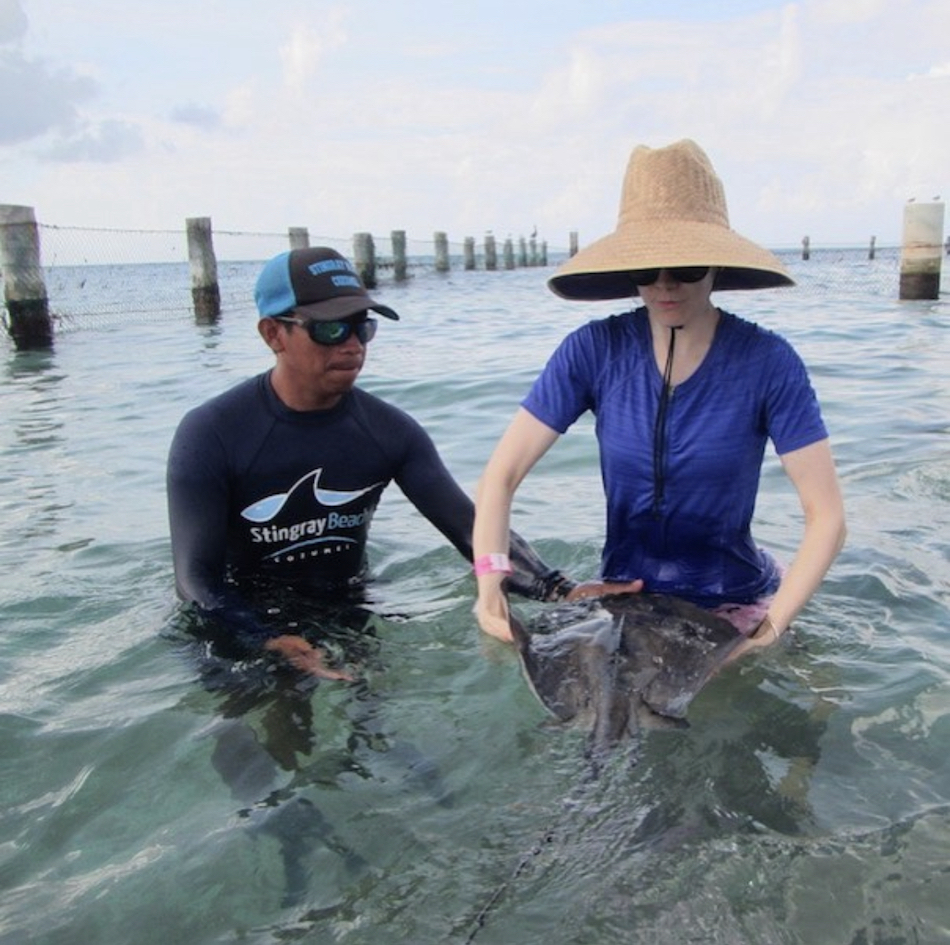
Day Trip to Cozumel for Snorkeling With Sting Rays
On the tiny island of Cozumel, Sting Ray Beach, also known as “The Sting Ray Sanctuary”, offers controlled-environment Sting Ray snorkels– one of the only places in the world where you can do a guided snorkel with stingrays!
Here, you can witness hundreds of string rays and fish cohabiting in the rehab portion of the coast where the sanctuary is located. Seeing hundreds of fish swirl around the stingrays here is super majestic– and no, they cannot “sting” you. The animals living here were de-barbed when they were injured. They live in captivity because they would not survive in the wild.
On site, you can pet, hold, and learn all about the string rays before you snorkel with them.
Conservation biologists lead the tours, often instructing visitors to do cheeky things like gently arching the rays’ wings to “fold it up like a taco”. (For the record, stingrays feel like blubbery pancakes, and they are weirdly adorable!)
On their bottom side, stingrays have gills where you can feel them breathing, and cute little mouths shaped like an upside-down U. In the wild, stingrays glide across the ocean floor like kite-shaped Roomba vacuums, using these small little mouths to eat small fish, oysters, snails, shrimp, squid, and the like.
Even though the animals here are in captivity, there’s nothing quite like the feeling of awe that snorkeling with stingrays in the ocean can inspire. (I cried, lol.)
There’s an entire universe tucked just meters beneath the surface on this reef– and between the abundance of animals and Cozumel’s crystal-clear waters, this experience might even inspire you to re-watch The Little Mermaid.
Overall, these creatures are insane, beautiful, terrifying, and inspiring all at once.
Most importantly, Stingray Beach is a protected rehabilitation center, so the money you pay for the snorkel goes directly to funding programs that work to get the offspring of these endangered stingrays back out into the wild. (They breed them and release babies into the wild once they are self-sufficient. Apparently, momma + poppa stingrays don’t feel any connection to their young, so they don’t “miss” them. (Or so we’re told.))
To get to Cozumel, take a short ferry from Playa Del Carmen, which is about a 30-minute drive from Tulum. For more information on Stingray Beach, go here.
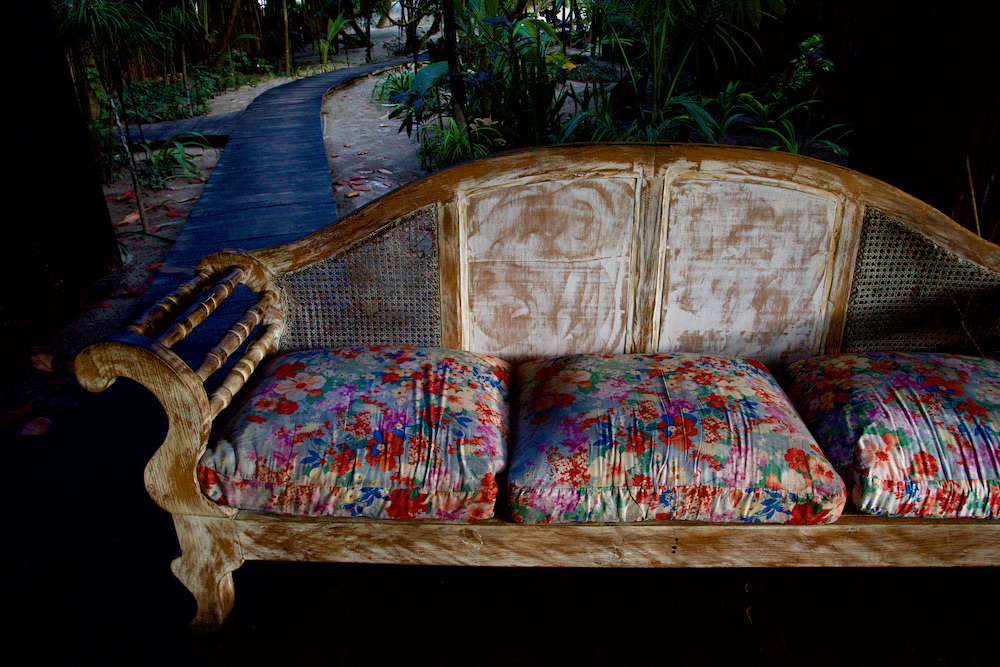
Other Cool + Useful Things to Note
- If you visit the Mayan Ruins, try to consciously take note of any iguanas that might be lounging there in the sun. Iguanas are a fixture of wildlife in Tulum. Local folklore even dictates that you’ll be cursed with bad luck if you don’t see an iguana before you leave. Basically, if you don’t see an iguana when visiting Tulum, you’re doing it wrong! So, be sure to consciously look out for them and make a wish when you see one.
- The tide is very weak in Tulum, so people don’t really surf here. It is, however, a great place to try Stand Up Paddle Yoga.
- You cannot drink the tap water in Tulum unless your hotel or Air BnB specifically says it is safe. Otherwise, you run the risk of getting Montezuma’s Revenge. Only drink sealed bottled water, and avoid ice unless you get it in a drink at a resort. My family typically uses bottled water to brush our teeth when we travel under these circumstances. (It sucks to have to use plastic, but it is still not safe to drink tap water in most of Mexico.)
- Tulum, Mexico runs on Eastern Standard Time (GMT-5).
- The local currency in Tulum is Mexican pesos, which are super beautiful and look kind of like monopoly money (if you’re coming from the U.S.).
- PSA: Neither Uber nor Lyft operates in Tulum. Instead, ask someone at your hotel’s front desk to hire you a taxi if you need to get to further-away places like Cancun, Playa Del Carmen, Coba, or the airport. Otherwise, Tulum itself is extremely walkable and bikeable. It is, after all, a tiny little beach town.
- When it comes to safety, Tulum is one of the safest tourist destinations in Quintana Roo. In part because the streets are well-lit and so well-attended by visitors and locals, crime is, by and large, not a concern. Obviously, you should exercise caution whenever traveling, but by way of comparison, Tulum is much less crime-ridden than say, Playa Del Carmen or Cancun.
- Because of its East-facing location, Tulum is a great place to see bright, dazzling sunrises. (As opposed to sunsets, which happen in the direction opposite the ocean.) Be sure to wake up early at least once during your trip to take in this phenomenon on Tulum Beach. With the silky-soft sand between your toes, it’s super peaceful and life-affirming. Then, enjoy the quiet morning serenity until the tourists arrive. 🙂
***
Related: Help save our oceans by using one of these Reef-Safe, Dermatologist-Approved Sunscreens whenever you travel.
For more bespoke travel guides, visit our Travel Well section.
Leave a Reply